Submit a Question to Michael Coulter
 Michael has been a member of the Canterbury Horticultural Society for over 45 years. During this time he has served on the Board, exhibited at shows and judged numerous garden competitions.
Michael has been a member of the Canterbury Horticultural Society for over 45 years. During this time he has served on the Board, exhibited at shows and judged numerous garden competitions.
Michael is our regular presenter at the monthly All About Gardening sessions. He has a lifetime of experience in horticulture starting as a school boy working after school and during holidays in a flower growing nursery, then studying at Lincoln College.
Nursery work with flowers and indoor plants, 12 years with the landscape department of the Ministry of Works and for the last 33 years with his wife running their own nursery.
He enjoys all types of horticulture and likes to share his knowledge and to solve problems for people to enable them to get more enjoyment and better results from their efforts in their gardens.
To submit a question please email the CHS on info@chsgardens.co.nz. Your question will be posted here and also answered in our regular electronic newsletter. To sign up for news click here
May 2020 Questions
Thanks for all the great questions this month
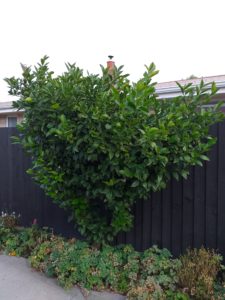 Q. This lemon tree is planted in a small patch of garden bordered by fence on one side and drive on the other. It is fed regularly and loves this spot as always yields a lot of fruit. Because of its location it has to be pruned regularly back from the drive. At the moment it has very dense growth in a triangle shape and a lot of new fruit. When should I prune this and how brutal should I be with it when I do. Thanks, Amanda
Q. This lemon tree is planted in a small patch of garden bordered by fence on one side and drive on the other. It is fed regularly and loves this spot as always yields a lot of fruit. Because of its location it has to be pruned regularly back from the drive. At the moment it has very dense growth in a triangle shape and a lot of new fruit. When should I prune this and how brutal should I be with it when I do. Thanks, Amanda
A. This is a common problem for lemons. You can prune a lemon at almost any time of the year but if it has much fruit on it you may not want to be cutting out the fruit right now. I like to do some of the pruning as I harvest the fruit by cutting back the stem that the fruit is on to a stronger branch so that you are pruning as you harvest. Lemons will get congested in the middle of a bush over time so will need to have the centre opened out and the bush shaped to allow plenty of light into the plant, this type of pruning is best done in the late spring as the plant shows signs of moving into growth as it is this growth that will flower to give the fruit development over the summer. Lemons will not grow during the colder time so any winter pruning will not encourage it into growth during this time.
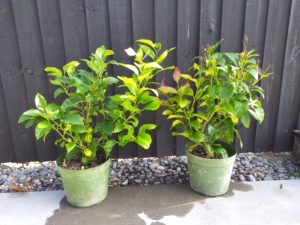 A.Yen Ben lemons are not as hardy as Meyer lemons so it may be better to grow them in a pot. Citrus are shallow rooting plants that need good winter drainage and plenty of moisture in the summer growing season. Yen Ben, if grown in the ground would also need some good protection from the frosts and to be in a good sunny position for winter sun.
A.Yen Ben lemons are not as hardy as Meyer lemons so it may be better to grow them in a pot. Citrus are shallow rooting plants that need good winter drainage and plenty of moisture in the summer growing season. Yen Ben, if grown in the ground would also need some good protection from the frosts and to be in a good sunny position for winter sun.
I have grown lemons and other citrus in large pots - from 35 litres and up to 100 litres using a tub and shrub potting mix, moving on into the next size pot once the roots have filled the pot. This may involve several repots before the plant is in its final pot. The best time to pot on lemons is in August/September just before they start their spring growth.
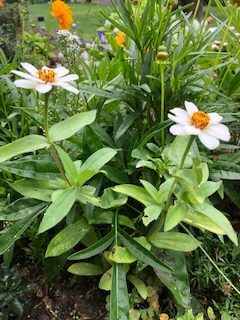 A. The flower looks like a zinnia to me. If it is a self sown zinnia the flowers are not likely to look the same as the parent as these are usually hybrids so that the self sown plants will revert to a more simple single type of flower.
A. The flower looks like a zinnia to me. If it is a self sown zinnia the flowers are not likely to look the same as the parent as these are usually hybrids so that the self sown plants will revert to a more simple single type of flower.
 Q. This picture shows the discolouration which has appeared on some of the buxus plants in our Villa garden. Can you identify the problem. A Summerset gardener is of the view that the problem is a mineral deficiency in the soil; Elizabeth considers it is possibly a disease of some sort. The colour certainly stands out on the few plants that are affected. I would be grateful if anyone can give come answers - We don’t want the whole hedge to get this. Malcolm
Q. This picture shows the discolouration which has appeared on some of the buxus plants in our Villa garden. Can you identify the problem. A Summerset gardener is of the view that the problem is a mineral deficiency in the soil; Elizabeth considers it is possibly a disease of some sort. The colour certainly stands out on the few plants that are affected. I would be grateful if anyone can give come answers - We don’t want the whole hedge to get this. Malcolm
A. The white margins on some of the leaves is constant with phosphate deficiency this may be caused by a lack of water due to the dry season we have had. The more orange colour does not look to me as a disease if it was buxus blight the leaves look a lot more straw like in colour and are very dry this will happen quite quickly after infection so I think that it may be just a more indication of the phosphate problem.
 A. The damage to the pohutukawa is caused by salt wind and once the leaves have died the stems will also dehydrate and die back. I would recommend that the damaged stems be cut back to healthy stems and the plant be given some protection from the wind with some windbreak cloth until it has become well established and is able to make new growth that is not damaged. This may take 2 to 3 years. In the summer the plant would benefit from plenty of water.
A. The damage to the pohutukawa is caused by salt wind and once the leaves have died the stems will also dehydrate and die back. I would recommend that the damaged stems be cut back to healthy stems and the plant be given some protection from the wind with some windbreak cloth until it has become well established and is able to make new growth that is not damaged. This may take 2 to 3 years. In the summer the plant would benefit from plenty of water.
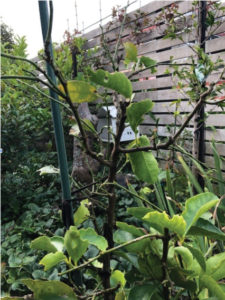 A. It is not uncommon for limes and lemons to drop their small fruit I think that is to expected. There does not look to be many leaves so there could be a root problem I think it may be better to wait until the spring to see if it will make new growth which would produce flowers. Limes (and lemons) will usually only get a small percentage of their flowers to reach mature fruit. Another thing to be mindful of is if it is too exposed and in a draught.
A. It is not uncommon for limes and lemons to drop their small fruit I think that is to expected. There does not look to be many leaves so there could be a root problem I think it may be better to wait until the spring to see if it will make new growth which would produce flowers. Limes (and lemons) will usually only get a small percentage of their flowers to reach mature fruit. Another thing to be mindful of is if it is too exposed and in a draught.
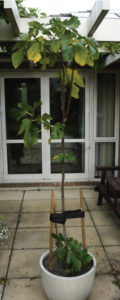 A. Figs that are grown in a cooler climate can be pruned back to brown wood as the fruit is produced on the new growth that is grown in the spring and will produce one lot of fruit per year. The growth produced in the autumn will have flower buds that will develop in December fruit with the new growth in the spring fruiting in late March and April giving two crops per season. Figs will grow well in pots even if pot bound and may stay in the same pot for several years and good quality potting mix should be used. Figs do not require a lot of nitrogen fertilisers as these promote vegetive growth.
A. Figs that are grown in a cooler climate can be pruned back to brown wood as the fruit is produced on the new growth that is grown in the spring and will produce one lot of fruit per year. The growth produced in the autumn will have flower buds that will develop in December fruit with the new growth in the spring fruiting in late March and April giving two crops per season. Figs will grow well in pots even if pot bound and may stay in the same pot for several years and good quality potting mix should be used. Figs do not require a lot of nitrogen fertilisers as these promote vegetive growth.
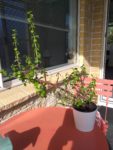
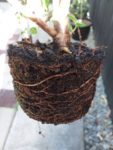



Though they both seem healthy as you can see from the photos these two plants are in desperate need of repotting. Can I please have advice on how to repot them and in the case of the anthurium advise on splitting this? What potting mix should I use and what size pot should I repot them into. they are both currently in a pot 13cm in diameter. Thanks, Amanda
A. Both plants will benefit from repotting using a good quality potting mix I would not split up the Anthurium, the jade plant (a type of portulaca) looks as though it needs more light for it to grow less spindly.I would think 150 mm pot would be about right.
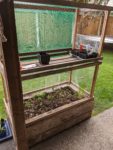
A. I would use a frost cloth or shade cloth in the summer and even perspex in the winter when there is less light for plants.
April 2020 Questions
Thanks for all the great questions this month
 A. You may prune Pseudopanax Laetus at any time of the year although I would wait until the spring as any new growth may be frosted in the winter here in Christchurch. I would suggest that a repot would be better in the spring for the same reason. Pruning cuts are best made where the the branches divide so as not to leave bare sticks that will die back.
A. You may prune Pseudopanax Laetus at any time of the year although I would wait until the spring as any new growth may be frosted in the winter here in Christchurch. I would suggest that a repot would be better in the spring for the same reason. Pruning cuts are best made where the the branches divide so as not to leave bare sticks that will die back.
Answer from HortTalk member: magnesium is yellowing in margins and shows in older leaves first, maganese similar but pops up in younger leaves first (can you remember the order?). I would feed some epsom salts (diluted) first google the amounts. Liquid feed is more quickly absorbed. Then put down some slow release citris fertiliser.. don't go crazy in the amounts, best to follow the instructions, you can over do it - I did that once and killed the tree (maybe it was too far gone anyway). I would do the same for the plants close by too. They might not be there yet, but might follow eventually. Good luck, i hope its not too late. Keep an eye on bug pests too, they are attracted to sick plants. My soil is not the best magnesium wise either.
Answer from Michael: The information above is generally correct although the leaves to me look more like iron deficiency. This may be caused by lack of water during the summer which will also be the reason for the leaves to drop. Lemons along with most plants that are stressed will drop leaves.Lemons along with most citrus are shallow rooted so need plenty of moisture during their growing season and do not like their roots getting too hot. A good mulch will be of benefit. Lack of water will cause nutrient deficiency in citrus.
Linda Erikson on Gardener's Swap Group - asked about this on HortTalk
A. Yes it is black spot (scab) and the sprays you ask about will help but I would add a fruit tree spray (these are usually a combination of fungicide and insecticide) after flowering and again in December.
Answers from HortTalk members: 1.2m isn’t so bad just make sure you Have a really good free draining mix in the hole. Pears are ideal
Answer from Michael: Stone fruit need good drainage so may not be suitable. Feijoas will be OK, plums may be OK pears as mentioned. Smaller fruits such as black currants raspberries and other cane fruits will be good as well.
 A. Coffee grounds are alright to use as a means of adding organic matter to the soil and as such would have some benefits to improve the soil but there would be little in the way of any nutrient value as they would be in very low amounts.I have seen some articles that have suggested that some plants do not like coffee grounds tomatoes and some of the other solanaceae family of plants.I would say that in moderate quantities they would be OK. but caution would be advised.
A. Coffee grounds are alright to use as a means of adding organic matter to the soil and as such would have some benefits to improve the soil but there would be little in the way of any nutrient value as they would be in very low amounts.I have seen some articles that have suggested that some plants do not like coffee grounds tomatoes and some of the other solanaceae family of plants.I would say that in moderate quantities they would be OK. but caution would be advised.
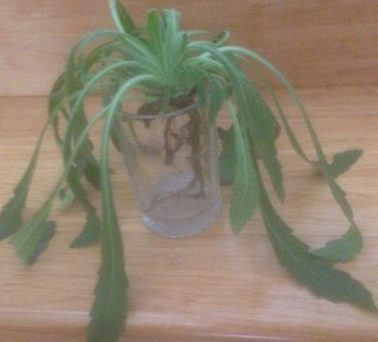 A: The plant is a common weed called broad-leaved fleabane (Conyza albida) which may be annual or perennial in your case it may be that it will flower next spring. It produces tall stems with very many small flowers that produce many wind borne seeds.I recommend that you remove the plants before they flower.
A: The plant is a common weed called broad-leaved fleabane (Conyza albida) which may be annual or perennial in your case it may be that it will flower next spring. It produces tall stems with very many small flowers that produce many wind borne seeds.I recommend that you remove the plants before they flower.
 A: Hi Beth, I have moved into a new garden and I am faced with the same problems that you have. To improve the heavy clay like soil will take some time, there is no instant fix. There are a couple of actions that can start the progress. First, add some gypsum, this helps to brake up the clay particles (this may need to be done each season for 2 to 3 years). Secondly, work in plenty of compost to improve the organic matter in the soil. It is not uncommon for the first crop of plants in new soil out of pasture to suffer from a lack of nitrogen. The addition of a balanced fertiliser will fix this. The drainage will be improved with my suggestions and each year will get better as the ground is work over by digging and hoeing.
A: Hi Beth, I have moved into a new garden and I am faced with the same problems that you have. To improve the heavy clay like soil will take some time, there is no instant fix. There are a couple of actions that can start the progress. First, add some gypsum, this helps to brake up the clay particles (this may need to be done each season for 2 to 3 years). Secondly, work in plenty of compost to improve the organic matter in the soil. It is not uncommon for the first crop of plants in new soil out of pasture to suffer from a lack of nitrogen. The addition of a balanced fertiliser will fix this. The drainage will be improved with my suggestions and each year will get better as the ground is work over by digging and hoeing.
Pictured: Evening sun sunflowers from Kings seeds, Silver Platinum corn from Koanga. Tomatoes are Moonglow and Tangella, and beans are Hidatsa Shield Figure bean and Blue Shakamaxon all from Heritage Food crops research trust. They're all shorter than they should be, probably because they were planted so late in the season.
 Growing your own plants from the seed you have saved yourself is very rewarding and something I do myself. The key to success is to sow the seed at the right time and use a soil or potting mix that is as clean as possible from weed seeds and any soil born diseases. I always use a free draining but moisture retaining potting mix or a seed raising mix. Larger seeds tend not to be too fussy but very fine seeds need more care. Some plants do need special conditions to germinate so you may need to do some research to get good results.
Growing your own plants from the seed you have saved yourself is very rewarding and something I do myself. The key to success is to sow the seed at the right time and use a soil or potting mix that is as clean as possible from weed seeds and any soil born diseases. I always use a free draining but moisture retaining potting mix or a seed raising mix. Larger seeds tend not to be too fussy but very fine seeds need more care. Some plants do need special conditions to germinate so you may need to do some research to get good results.
These lilies only need to be lifted if you are going to shift or divide them. Best to feed them when they start growing in the Spring. The roots of lilies are active all the time so if you are lifting them replant straight away, do not allow them to dry out.
All plant material should be sprayed with an insecticide before it is removed. Wash down the inside of the greenhouse and then treat with a biocide. Keep the greenhouse free of plant material until it is time to plant the next crop so that there can be no hosts for the white fly and then follow a spray programme at the first sign of any white fly.
No, as long as the pumpkins are mature at harvest they should be sweet enough although I have found that after about a month the pumpkins are a lot sweeter and are a brighter colour. A hard frost can damage them and reduce their keeping ability.
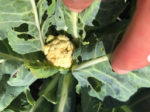 The damage is by the white butterfly. There is an organic approved spray available called 'Success' that can be used.
The damage is by the white butterfly. There is an organic approved spray available called 'Success' that can be used.
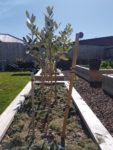
 Feijoas make a good hedge as they will grow from hardwood. To encourage this prune back the top growth quite hard in the Spring. Just before they start to grow you can be hard cutting back to 3 to 4 leaves above the branches from the main stem (think of this as an investment to the hedge).
Feijoas make a good hedge as they will grow from hardwood. To encourage this prune back the top growth quite hard in the Spring. Just before they start to grow you can be hard cutting back to 3 to 4 leaves above the branches from the main stem (think of this as an investment to the hedge).
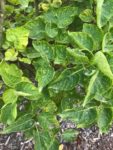 The leaves look very much like they have the potato psyllid, a small sucking insect that spreads a bacteria to the plant. Control of the insect is by using a insecticidal spray.
The leaves look very much like they have the potato psyllid, a small sucking insect that spreads a bacteria to the plant. Control of the insect is by using a insecticidal spray.

 Immature green vegetable bugs.
Immature green vegetable bugs.
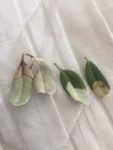 The leaf damage looks to be a physical one. It could be that the plants are not yet acclimatised to their new position (not hardened off from the nursery) or some salt spray from the sea. I do not believe they have any disease.
The leaf damage looks to be a physical one. It could be that the plants are not yet acclimatised to their new position (not hardened off from the nursery) or some salt spray from the sea. I do not believe they have any disease.

